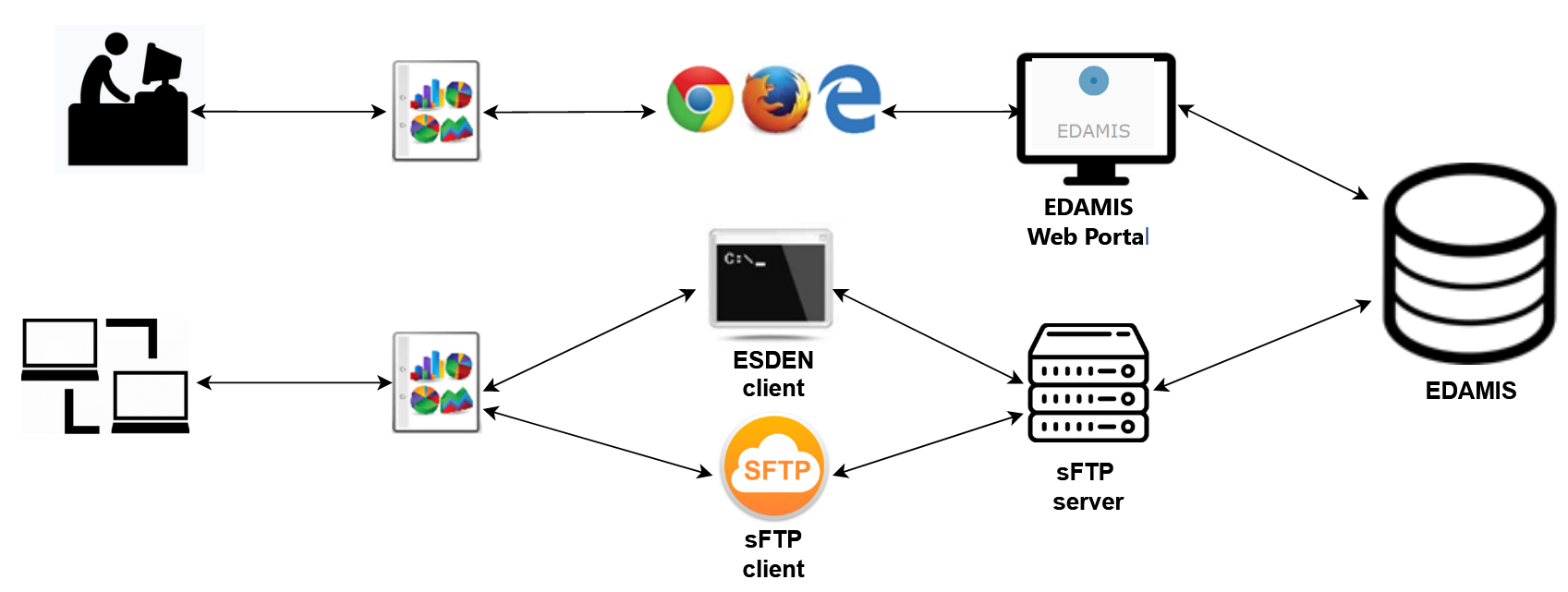EDAMIS
EDAMIS is the single entry point for data transmission to Eurostat. It is used by:
- National agencies to send data to Eurostat
- Eurostat to share data with national and international agencies

Login requirements, including how to activate the 2 Factor Authentication feature are described in this FAQ.
Contact & Help
For queries on data and metadata transmission, including issues accessing EDAMIS, bugs observed and any other support requests, please send an email to ESTAT-DATA-METADATA-SERVICES@ec.europa.eu
National transmission coordinators are Eurostat's primary contact point at the national level. They can grant access to EDAMIS, as well as perform other key actions.
Maintenance Calendar
User guides
The EDAMIS short user guide offers a comprehensive description of the main EDAMIS features
The EDAMIS pre-validation user guide provides all the information required to make use of this optional service
Find out all available transmission methods in EDAMIS to exchange files on the How to exchange files using EDAMIS 4
FAQs & explanatory videos
Find out answers to the most Frequently Asked Questions (FAQs) about EDAMIS
Learn how to take key actions via the EDAMIS explanatory videos
Training opportunities
Data providers, national transmission coordinators and Eurostat domain managers can profit from the EDAMIS learning activities which are organised regularly, showcasing the application's main features:
- Learn more about the EDAMIS course
- Check out the training calendar and register for the next session available.
In a nutshell
|
Eurostat is required to:
The transmission and the delivery of the datafiles are managed by EDAMIS (ELECTRONIC DATA FILES ADMINISTRATION AND MANAGEMENT INFORMATION SYSTEM). Since May 2009, the European Statistical System Committee (ESSC) approved to only use EDAMIS for the transmission of data files from national authorities to Eurostat. The ESSC has thus adopted EDAMIS as the Single Entry Point for the transmission of data to Eurostat.
Main features of EDAMISThe DATASET INVENTORY within EDAMIS lists the statistical domains and the datasets within each domain. Dataset names are constructed by joining together:
Additional metadata concerning each domain and dataset are stored, including information about the unit and individuals responsible within Eurostat, the basis for the collection (such as a legal act) and the deadline for sending the data. EDAMIS also holds a list of all organisations sending data to Eurostat, categorised as:
and information concerning the authorised senders in each of the organisations. The EDAMIS system allows the user to send data to Eurostat using secure transfer protocols. In case of confidential data, EDAMIS allows users to enable PGP ENCRYPTION of the transmitted data files for additional security. When the data files reach the central server in Eurostat, EDAMIS sends an official email acknowledgement (receipt) for the dataset/period to the actual data sender and any other individuals nominated by the sending organisation. The file is then delivered to a server/directory assigned to the relevant Eurostat production unit, and the individuals responsible for handling the data are notified by email that the data has arrived. Delivered files are named in a standard format in accordance with the DATASET NAMING CONVENTION (DSNC): the dataset name, the sending country, the period of the data (e.g. year/month or sequential). The IT system logs the whole transmission chain. After the Eurostat production unit has processed the file or after Validation has been processed, EDAMIS can, if appropriate, send the data provider FEEDBACK. This may take the form of written comments or log files showing any errors discovered in the course of file processing. EDAMIS allows incoming feedback to be automatically FORWARDED to Eurostat contractors or other organisations with an interest, such as the OECD and the European Central Bank. EDAMIS can also be used to send REMINDERS that data are expected, based on the intervals between data transmissions and the deadline for each dataset. Reminders can be sent on the start of the transmission period, before the deadline, on the day of the deadline and after the deadline. They are sent if the obligation to send is laid down in a legal act or agreement (not if data submission is voluntary) and the dataset/deadline has not been sent by the date of the reminder. The EDAMIS Web Portal offers a full range of REPORTING functions. Detailed information on domains, datasets, statistical products and organisations is available. Country/organisation links to domains and datasets can be produced, as can lists of people connected with these links. In addition to statistics and the Compliance Indicator for any required period, reports on data transmissions and timetables can be drawn up. The reports are available to all users registered with their national associations.
Transmission toolsOrganisations can use the EDAMIS WEB PORTAL or/and the available automated transmission methods to send or receive a data file of any format and size. The EDAMIS WEB PORTAL is internet-based, which means it does not have to be installed locally by users. The EWP uses the EU Login user authentication system and is best-suited for the manual transmission of data files to Eurostat. The AUTOMATED TRANSMISSION METHODS available are sFTP and ESDEN Client. These 2 transmission methods require local installation and are more suitable to automatic transmission or to the exchange of very large datafiles.
|
Other resources
For testing purposes, you may be asked to use EDAMIS Acceptance environment. Access to the EDAMIS Acceptance environment can be obtained using the same procedure as in Production, with the difference that users should register and request rights in EDAMIS Acceptance rather than Production.


